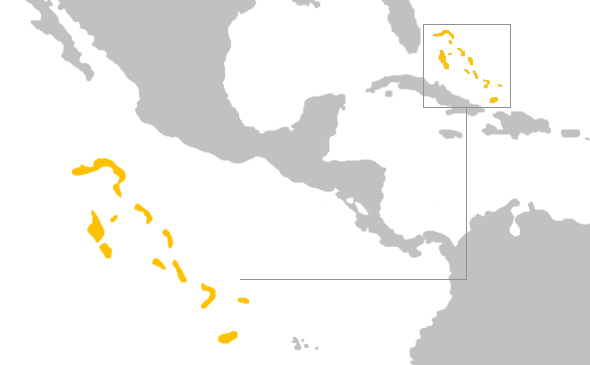Surfing in Bahamas

The Bahamas is an exotic archipelago located in the north part of the Caribbean Sea. This magical group of islands has attracted many visitors searching for the white sandy beaches, crystal clear waters and all kinds of tropical wildlife. The Bahamas is formed by 29 islands, 661 cays and 2.387 islets that offer great conditions for all kinds of water sports throughout the entire year including scuba diving, snorkeling, swimming and of course surfing. Despite the fact that the Bahamas is not famous for being a surf destination the country has excellent waves. The Abacos, the Rum Cay and the Eleuthera island receive consistent swells that produce high quality waves that would blow any surfers' mind. Lots of surfers come to the Bahamas because of the incredible winter surfing season that goes from October through April for size and consistency. This is when strong cold fronts come from the north atlantic ocean and the winds typically switch offshore and the surf gets really good. The best part of surfing in the Bahamas has to be the warm water all year round and the lack of crowds that give the visitors a feeling of seclusion and privacy that comes with having the beach and the water practically all to yourself making the archipelago a true paradise on earth for any surfer.
Climate in Bahamas
The climate in the Bahamas is tropical, with two seasons. There is a warm and rainy season from May to October usually called summer and a cooler and drier season from November to April generally called winter. Trade winds blow constantly making the heat index lower. September to May is the most popular time to visit the archipelago due to the low amount of rainfall. Summers register the highest temperatures and higher humidity. Some resorts and hotels shutdown during this time of the year but there are still plenty of options for accommodation. It’s usually a good time to take advantage of lower seasonal prices.
The Bahamas have about 340 sunny days a year and even during the rainy downpours are usually short-lived. The best time to surf in the archipelago is from October to April when strong swells coming from the northeast reach the coast of the country. From May to July, it's usually less consistent and small. From August to October is the least consistent time of the year but the hurricane season brings the possibility of really good waves. The water temperature is warm throughout the whole year and averages 24°C (75°F) in the winter, 27°C (80°F) in the spring and 31°C (88°F) in the summer.
Best surf spots in Bahamas
There are plenty of surf spots in the Bahamas. Here are the best and most famous surf spots in the country: Punta Rocas, Indicas, Surfer's Beach (Gregory Town), Garbanzo, Egg Island, St. George Island, Man Island, Harbour Island, Whale Point, Holiday Beach, Hatchet Bay, Rainbow Bay, James Point, Half Sound, North Palmetto Point, Diamond Cay, Rock Sound Airport and Willawahs.
Budget Planning
Meal price range
Simple meals start at $15 USD. Mid-range meals start at $35 USD. Dining & drinking at high-end restaurants can cost anywhere from $120-150 USD
Equipment rental
There are a couple places that rent gear. Boards start at $15 USD a day.
Prepaid SIM cards
BTC is a good choice. SIM cards can be purchased from supermarkets, kiosks, drug stores and official retailers.
Prepaid packages start at $10 USD.
Public transport
The best way to get around the Bahamas is by jitneys (public buses) which operate every day from 6:30 a.m. to 7 p.m., with reduced hours on Sundays.
Traveling between Bahamian islands requires either flying from Nassau's airport using the inter-island air service, or hailing pricey water taxis ($30-80 USD).
Taxis can be easily flagged down on all of the islands, they are quicker and easier than driving on your own and it is the second best way to get around when jitneys aren't available.
Renting a car starts at around $50 USD a day.
Gas prices
$1.22 USD a liter.
Types of risks
Rock reef, the dumping shorebreak, and the boneyard. Locals can point out the boneyard for you. Hurricanes.
How to prepare
Visa
Citizens from 120 countries, including EU, US, and Australia, can enter the Bahamas without a visa for up to 90 days.
Vaccines
Although it's not mandatory, it’s recommended that you have been vaccinated for hepatitis A & B, yellow fever, typhoid, rabies, meningitis, polio, Tdap, chickenpox, shingles, pneumonia, influenza, measles, mumps and rubella. You’ll be asked to show proof of your yellow fever vaccination if you come from a country with a risk of yellow fever.
Things to know
Language & Currency
English is the official language.
The currency is Bahamian dollar (B$).
Best time to go
October to April when strong swells coming from the northeast.
Checking Surf forecast
Checking the forecast about a week before your trip is always a good idea. Understanding what the waves will be like and knowing what gear to pack is essential. You can check the forecast for the waves here.
Do I need pack a pharmacy kit
You should bring a basic kit. Including ear drops, eye drops, bandaids, ear plugs, gaze, alcohol, mosquito repellent and broad spectrum antibiotic ointment.
Travel/Surf Insurance
World Nomads has great travel insurance packages that are not super expensive and they cover surfing.
Emergency
Dial 911
Check surf pictures of the Bahamas at #bahamassurfing.

